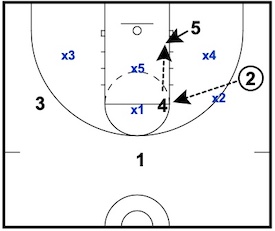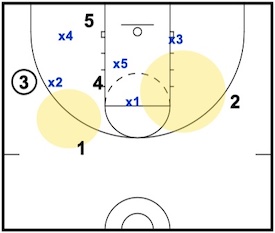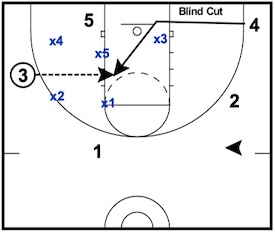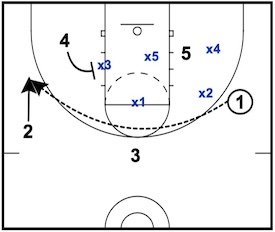5 Concepts To Beat a Zone Defense
Zone defenses have been flustering offenses for decades.
While a zone defense can make life difficult for offenses by giving them a different look, hiding poor defenders, forcing outside shooting, and making offenses do things they aren't comfortable with...there are plenty of best practices a team can take when attacking a zone.
Offensive teams will sometimes settle for outside shots, merely pass around the perimeter, and become stagnant on offense.
Here are 5 offensive concepts that you can implement to beat zone defenses and pile up some points on the scoreboard!
1 - High Low
Attacking from the elbow with high low action is always an effective way to attack a zone defense.
When the ball is in the middle of the zone, it forces defenders to make decisions, it collapses the defense, and opens up passing lanes.
Most teams will elect to put a post player in this spot, but another good strategy is to put a high-quality playmaker and decision maker in this spot who can find open teammates or score for themselves.
Danny Miles who won over 1,000 games at the college level first made us aware of this tactic.
Now, let's look at the diagram.
Once you enter the ball to the high post (4), you can look to enter the ball to the short corner (5). The short corner can slide into an open area near the basket.
If the bottom defender collapses (x4), a pass to 2 sliding in the corner can also be open.
Oftentimes, the opposite bottom defender (x3) will also drop. This opens up 3 for a skip pass and open perimeter shot.

2 - Attacking from the Short Corner
The short corner is another great spot to attack a zone defense from.
If the ball is in the short corner, the player with the ball can see almost the entire floor. This allows them to see players spotting up or cutting into open gaps.
In the diagram, the short corner (5) has plenty of options.
Look for the high post player (4) to dive to the basket.
The top (1) and the opposite wing (2) space to open gaps.
As noted in the diagram, the dive could engage x3 which will open up 2 for a skip pass or a cut to the basket.
The ballside wing (3) acts as an outlet. However, if x4 moves out of position, 3 can also be open for a shot.

3 - Equiangular Triangles
When attacking a zone, spacing is one of the most valuable ways to get high-efficient shots.
One way to do that is with equiangular triangles: equally spacing off the ball between two defenders.
What this does is put the defense in a compromising position away from the ball and forces two players to worry about one offensive player.
If your team can do this from multiple spots on the floor, it opens up the entire floor for the rest of your offensive scheme.
This creates indecision for the defense, spaces the zone defense out, and properly positions your players for quick ball reversals.
This is often enough to get a scoring opportunity for your team!
As shown in the diagram, 1 and 2 form equiangular triangles.
1 creates indecision for x1 and x2.
2 creates indecision for x1 and x3. If 2 is higher up on the wing or deeper in the corner, they are too easy to guard and it removes defensive indecision.

4 - Blind Cuts
A "blind cut" is any time a player cuts from behind a defender's head and into an open gap.
It's a great way to put pressure on the backside of a defense and cut into a gap for an easy pass.
Rather than just standing in an open gap and being easy to see and defend, blind cuts are unpredictable and hard to see coming.
Once the ball is caught in a spot like the high post or short corner, the player can then attack appropriately.
In the diagram, the player in the opposite corner (4) cuts behind the zone and into a gap around the mid-to-high post.
Depending on x3's action, 2 is open for a perimeter shot or cut to the basket.

5 - Pin Screens
A pin screen can also be used to attack zone defenses.
If a zone defense is overloading to one side of the floor, having an off ball offensive player screen the back of a defender can open up skip passes.
Once a skip pass is received, the player can shoot the open shot or dump the ball inside.
In the diagram, 4 sets a pin screen on x3. 2 slides to an open spot behind the screen.
Setting pin screens also opens up the backside of the zone. If x3 cheats on the screen, 4 is wide open.
You can even use double pin screens to create open shots on the weakside. In the diagram below, 4 would screen x3 and 2 would screen x1. 3 would cut to the open area on the opposite wing.

Don't just settle for moving the ball around on the perimeter, getting no ball penetration against the zone, and throwing up three pointers because there's nothing else available.
Teach these concepts to your players to make them a zone-thrashing machine!
Zone Offense Resources
Continuity Zone Offense & Concepts To Beat Any Zone Defense with Don Kelbick
Beating the Zone - 75 Variations of the Best Zone Plays (eBook)
|
|||


 Facebook (145k Followers)
Facebook (145k Followers) YouTube (152k Subscribers)
YouTube (152k Subscribers) Twitter (33k Followers)
Twitter (33k Followers) Q&A Forum
Q&A Forum Podcasts
Podcasts